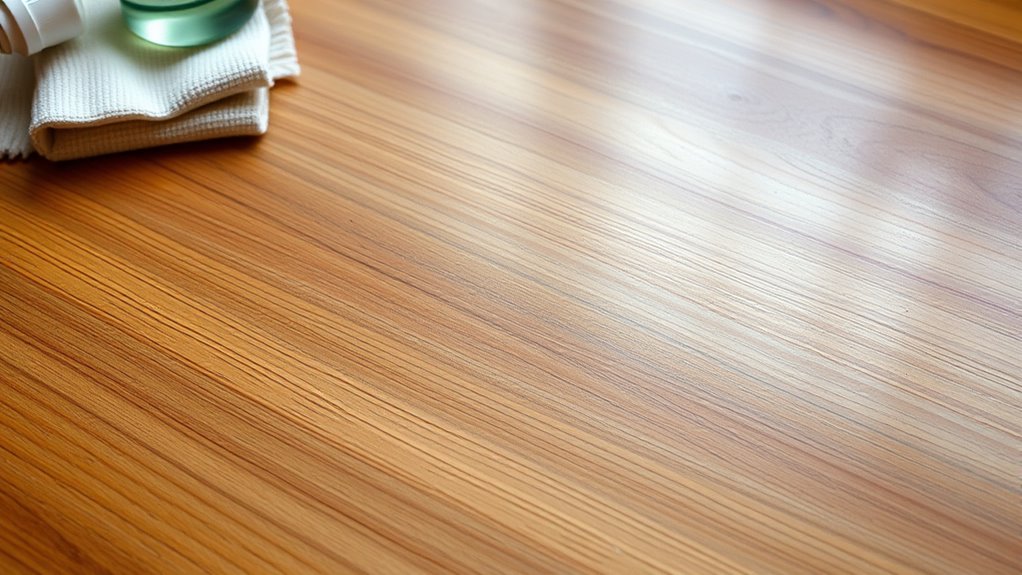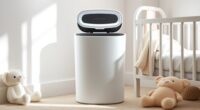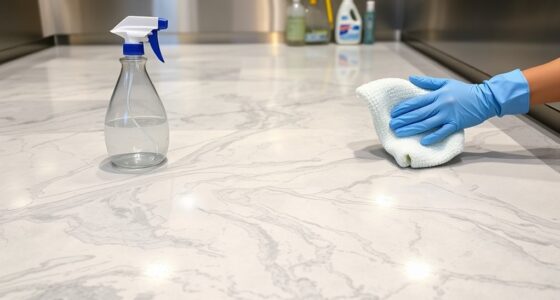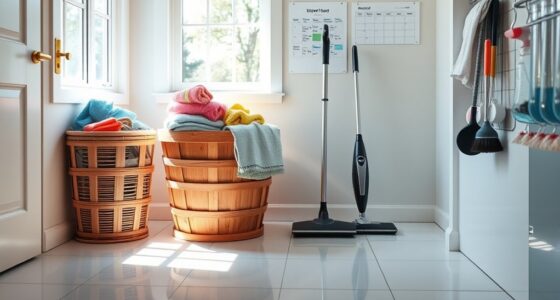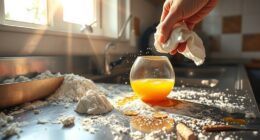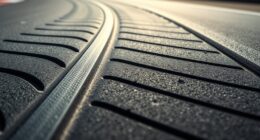One common mistake is using improper cleaning techniques or abrasive tools that can scratch or dull your engineered wood floors. Avoid harsh chemicals, steel wool, or overly wet mops, as these can cause long-term damage or warping. Instead, use gentle, product-specific cleaners and a slightly damp microfiber cloth. Proper polishing and stain removal methods also help maintain your floors’ shine. Keep exploring to discover more tips for keeping your engineered wood floors looking their best.
Key Takeaways
- Avoid improper polishing techniques; use gentle, specifically designed products and circular motions to restore shine safely.
- Steer clear of abrasive cleaners and tools like steel wool that can scratch and damage the veneer surface.
- Gently blot stains with soft cloths and mild solutions; avoid harsh chemicals that can strip the finish.
- Use a barely damp microfiber cloth and control moisture levels to prevent swelling, warping, or delamination.
- Choose compatible, high-quality products formulated for engineered wood to prevent residue buildup and dull patches.
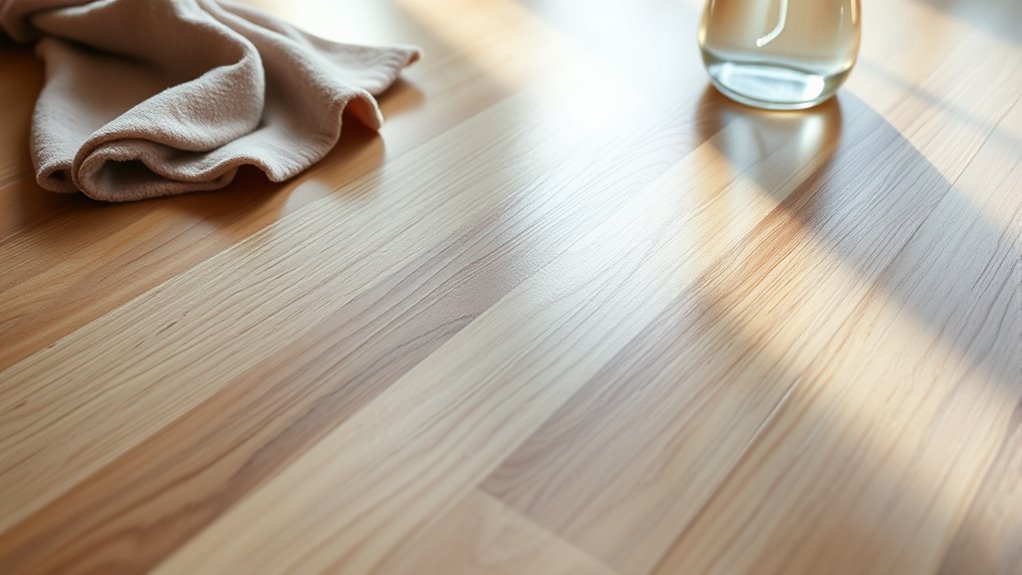
Cleaning engineered wood floors might seem straightforward, but making a few common mistakes can cause lasting damage. One of the biggest errors is neglecting proper polishing techniques. Many people think that simply buffing the surface with a cloth or using harsh chemicals will restore shine, but this can actually harm the finish. Instead, you should use gentle polishing techniques designed specifically for engineered wood. Apply a high-quality wood floor polish or a microfiber cloth to buff the surface in circular motions. This helps to enhance the floor’s natural luster without creating scratches or dull spots. Avoid abrasive cleaners or steel wool, as these can scratch the veneer layer and dull the overall appearance.
Another mistake involves improper stain removal methods. If you notice a stain or spill on your floor, rushing to scrub it away with rough tools or strong chemicals can make things worse. Instead, start by gently blotting the stain with a soft cloth or sponge dampened with a mixture of mild soap and water. For stubborn stains, you might need a specialized wood floor stain remover, but always test it on a small, inconspicuous area first. Avoid using ammonia, bleach, or other harsh chemicals that can strip the finish or discolor the wood. The key is patience and gentle cleaning—scrubbing too hard or applying harsh substances can cause the stain to set deeper or damage the protective layer.
Additionally, many overlook the importance of proper cleaning tools. Using a damp mop or microfiber cloth rather than a soaking wet mop prevents excess moisture from seeping into the seams and damaging the engineered core. Excessive water is one of the biggest enemies of engineered wood floors, as it can cause swelling, warping, or delamination over time. Always ensure your cleaning equipment is well-wrung and slightly damp, never dripping. When it comes to polishing, avoid aerosol sprays or wax-based products unless they’re specifically formulated for engineered wood, as incompatible products can leave residues that attract dirt or create dull patches.
Frequently Asked Questions
Can Vinegar Damage Engineered Wood Surfaces?
Vinegar can damage engineered wood surfaces if used improperly. Its acidity may break down the finish or cause discoloration, posing chemical risks. When you’re exploring DIY solutions, it’s better to opt for pH-neutral cleaners specifically designed for engineered wood. Always dilute vinegar properly and test in a small area first. This way, you avoid potential damage and keep your flooring looking its best without risking costly repairs.
How Often Should I Clean Engineered Wood Floors?
Frequently, you should clean engineered wood floors about once a week to keep them pristine. Properly, you’ll want to sweep or vacuum to remove debris swiftly, then softly scrub with a damp mop for floor polishing perfection. Regular cleaning prevents dirt buildup, prolongs the planks’ lifespan, and preserves their luster. Remember, consistent care curtails costly repairs, ensuring your engineered wood floors stay stunning, shiny, and specifically safe from damage.
Is Steam Cleaning Safe for Engineered Wood?
Steam cleaning isn’t the safest choice for engineered wood floors because high heat and moisture can damage the surface and affect the engineered wood effects. You might think it’s effective, but it risks warping or delaminating your floors. Instead, stick to gentle, damp mopping with approved cleaners. This way, you preserve the look and longevity of your engineered wood, avoiding costly repairs or replacements down the line.
What Cleaning Products Are Best for Engineered Wood?
For engineered wood maintenance, use gentle, pH-neutral cleaners specifically designed for wood floors. Avoid harsh chemicals, ammonia, or bleach, as they can damage the finish. A soft mop or microfiber cloth works best for cleaning. Follow wood cleaning tips by regularly sweeping or vacuuming to prevent dirt buildup. This helps maintain your floor’s appearance and prolongs its lifespan while keeping the surface safe and beautiful.
How Do I Remove Stubborn Stains From Engineered Wood?
To remove stubborn stains from engineered wood, start with gentle DIY stain remedies like a mixture of baking soda and water or a mild soap solution. Use a soft cloth to apply the solution and gently scrub the stain. For tougher stains, you can try a small amount of white vinegar. Always test first in an inconspicuous spot to avoid damage, and avoid harsh chemicals that can harm the finish.
Conclusion
Avoid these common mistakes, and your engineered wood will stay beautiful for years. Think of your floor as a delicate masterpiece—like a fine painting needing gentle care. With the right cleaning habits, you’ll preserve its charm and shine, turning your space into a sanctuary rather than a battleground. Remember, even Cinderella’s slipper remained pristine with proper care; so, treat your floors with kindness, and they’ll reward you with lasting elegance.
